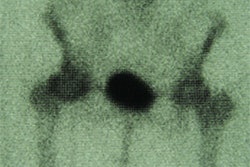VIENNA - The wrist has a complex ligament system that provides balance, support, and a wide range of movement. However, when trauma tears the ligaments, the region must be carefully evaluated to determine the extent of the lesions and delineate the precise location of each tear, according to Dr. Thomas Ludig of the Service d'Imagerie Guilloz, Hôpital Central in Nancy, France.
Until now, imaging for suspected wrist tears has required the acquisition of two sets of images on single-slice CT, he said. But Ludig and his colleagues wondered if high-resolution multislice CT -- which can produce 25 line pairs per centimeter resolution under optimal conditions -- would enable adequate visualization of suspected tears in a single acquisition.
"Currently, arthrography alone is not sufficient to define all ligament tears," Ludig said. "Until now, single-slice CT wrist arthrography required the use of direct axial and direct coronal slices to analyze wrist ligaments. So the purpose of our study was to determine whether a single axial slice acquisition with MPR [and multislice CT] would allow us to forego the acquisition of direct coronal slices."
If successful, the new technique would also overcome problems such as artifacts seen on direct coronal CT slices due to incomplete flexion of a painful wrist during imaging, he added.
At Tuesday’s musculoskeletal imaging sessions of the European Congress of Radiology, Ludwig presented a study of 36 consecutive patients presenting with post-traumatic wrist pain. All patients underwent CT arthrography consisting of transaxial and direct coronal slices that were 0.5-mm thick, postprocessed with multiplanar reconstruction (MPR) on a Siemens Medical Solutions Somatom Plus 4 CT scanner. All patients concurrently underwent radiocarpal and/or metacarpal arthrography.
The CT arthrographies were evaluated independently by two radiologists, who assessed wrist ligament tears and the size of triangular fibrocartilagenous cartilage complex (TFCC) tears.
"First, the axial-coronal slices were read, and secondly, axial slices and coronal MPR were read. The slice analysis focused on the scapho-lunate, the luno-triquetral, and the TFCC. Each ligament was examined to determine the absence or presence of ligament tears," Ludig said, and the size of the TFCC tear was evaluated as less than 1 mm, 1-3 mm, or > 3 mm.
Using direct axial plus coronal slices as the gold standard, the radiologists found scapho-lunate tears in 35% of patients (11/36), luno-triquetral tears in 42% (16/36), and TFCC tears in 24% (10/36). Seven patients had tears in all three ligaments.
Both intraobserver and interobserver agreement was excellent: Kappa (K) 0.94 and 0.89, respectively. Agreement for the diagnosis of ligament tears was K=0.96 and 0.98 in the scapho-lunate ligament; K=1 and 0.98 in the TFCC; and K=0.86 and 0.78 for the luno-triquetral ligament. However, agreement was moderate for evaluation of the size of the TFCC tear (K=0.62 and 0.47, respectively).
"Images produced with single axial slice MPR are (of) sufficient quality for good analysis of ligaments, cartilage, and bone, although it must be noted that cartilage and bone were not evaluated in our study," Ludig said, noting that the technique could be recommended for most applications.
"Multiplanar analysis of the wrist is necessary, and only one acquisition is sufficient for ligament analysis," he concluded.
Session co-chair Dr. A. Chevrot from Paris commended the quality of Ludig's images and technique. However, he noted, "I think the best way to do a comprehensive evaluation of the wrist is doing an axial acquisition slice and then MPR in the (desired) direction: sagittal and oblique coronal."
By Eric Barnes
AuntMinnie.com staff writer
March 7, 2001
Click here to post your comments about this story. Please include the headline of the article in your message.
For more coverage of the European Congress of Radiology, visit our RadCast@ECR special edition.
Copyright © 2001 AuntMinnie.com



















